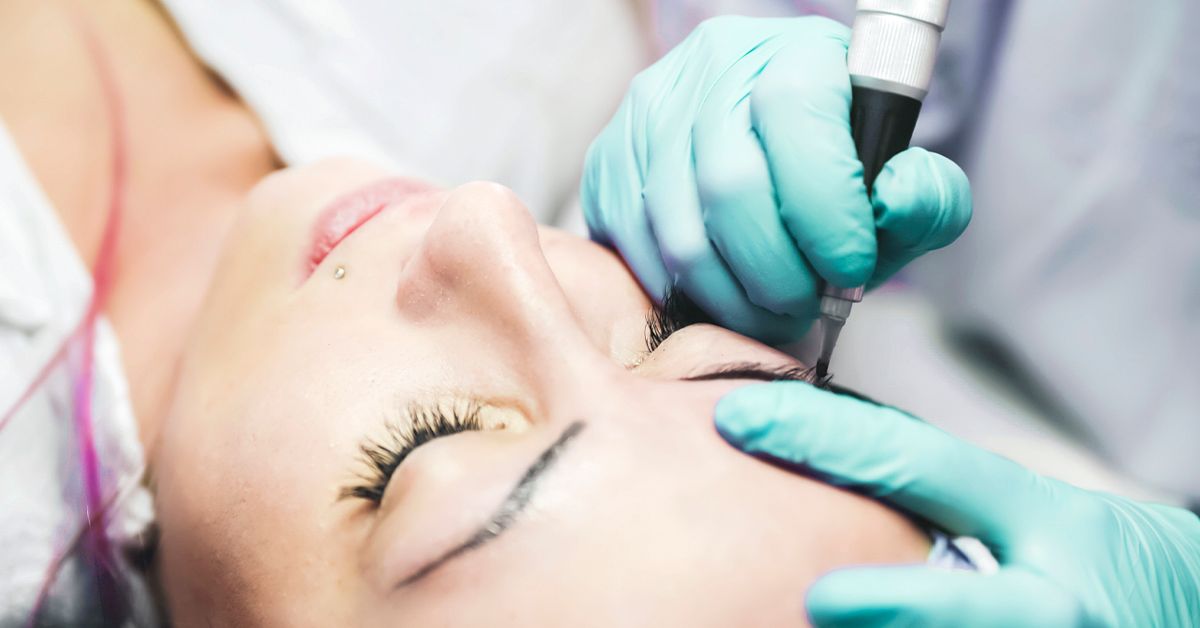Play all audios:
If you have thin or light-colored eyebrows, or one of the many medical conditions that causes eyebrow hair loss, like alopecia, microblading may seem like a dream come true. Microblading is
a semi-permanent cosmetic tattoo that fills in thin eyebrow areas to make them look naturally fuller. The procedure involves using a bladed tool to apply a line of semi-permanent pigment
under the skin Microblading produces a natural-looking feathery brow, and results can last for up to 3 years, though more frequent touch-ups are needed about every 18 months. Although the
procedure can take upward of 2 hours, most people report only feeling minor pressure or discomfort and less pain than a typical tattoo due to the use of a numbing cream. Of course, this will
depend on your own personal tolerance to pain. Some level of pain or discomfort should be expected. If you’re considering microblading, be sure to properly research the provider. Ask to see
examples of their work. Make sure the technician will be using a topical numbing ointment on the brow area to help reduce pain. There are a few steps you can take to help minimize pain and
swelling after the procedure. Does microblading eyebrows hurt? As the name suggests, microblading is essentially having hundreds of tiny cuts made on your brow line. Just like a tattoo,
these little cuts break the skin, which is then filled in with a pigment. Most practitioners will use an anesthetic to numb the area prior to starting the procedure. So, rather than actually
feeling the pain from the cutting of the blade, you’ll most likely only feel pressure from the microblading tool on your face, or you might feel a scratching sensation. During the process,
you may also hear loud scratching or crunching sounds, sort of like feet crunching on compacted snow. Pain will be worse if no anesthetic is used, or if you tend to have a low pain
tolerance. It may feel like something is scratching the skin over and over again. Be sure to discuss the use of anesthetic with your practitioner before starting the procedure. It can take
30 minutes or more before the numbing cream begins to take effect. As the procedure continues, your practitioner will begin adding cuts on top of or close to existing cuts. Your skin may
begin to feel irritated or burned, sort of like a sunburn. The practitioner may take turns going from one eyebrow to the other. They may add more anesthetic to the resting eyebrow during
this time. While some minor discomfort and skin irritation should be expected, you may be able to lessen the tenderness and irritation experienced during microblading by following these
steps before your appointment: * Avoid caffeine or alcohol on the day of the procedure. * Avoid tanning or sunbathing for a few days before the procedure. * Don’t pluck or wax your eyebrows
for a few days before the procedure. * Avoid chemical peels, laser treatments, and other facial treatments for a few weeks before the procedure. * Stop using vitamin A (retinol) for a month
beforehand. Microblading pain vs. tattoo pain Microblading typically uses a different type of tool than a tattooing needle, but it’s still considered a tattoo since penetration of the blade
into the skin is needed to deposit pigment. Traditional tattoos use a machine, while microblading typically uses a manual tool. Microblading isn’t permanent. The pigment is inserted into the
upper layers of the skin. Microblading will most likely feel different and hurt less than a traditional tattoo because of the numbing cream (anesthetic) applied prior to the procedure, and
because there are fewer needles involved. As a rule, traditional tattoo professionals don’t use any anesthetics for their tattoo procedures. Still, microblading is subject to the same risks
as tattooing, including infection and allergic reactions to the pigments used. In rare cases, serious reactions can occur. Pain following a microblading procedure It’s very common for the
area to feel bruised or tender for about a day following a microblading procedure. Your skin shouldn’t appear bruised, but it may be a little red. As the wounds heal, you may feel as if you
have a sunburn for a few days. It takes about 10 to 14 days to fully heal as the pigment settles. During this time, your skin will be sensitive. To help prevent complications and to assist
with the healing process and avoid infections, follow the aftercare instructions provided by the microblading technician. These may include the following: * Apply coconut oil to your
eyebrows twice a day until healed. * Keep the area clean and dry. * Avoid touching, rubbing, picking, or wetting the brow area for a week to 10 days. * Avoid using any harsh skin care
products. * Don’t apply makeup to the area for a week. * Try to avoid sweating for a couple weeks. * Stay out of direct sunlight, including tanning beds. Takeaway A numbing cream is
typically used during a microblading procedure. Some people will still feel pain during the procedure, and soreness or irritation is expected in the days following. By properly researching
the microblading provider and following all pre- and post-care instructions, you can ensure a relatively painless and safe appointment. A provider with accreditation from either the American
Academy of Micropigmentation or the Society of Permanent Cosmetic Professionals (SPCP) is likely to have more credibility and training in microblading and is a good place to start.

